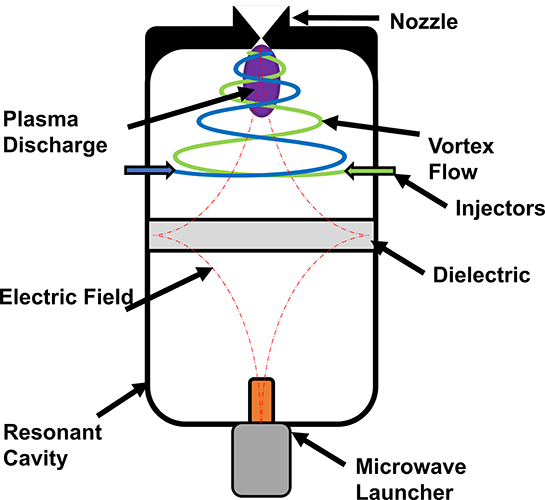Microwave Electrothermal Thrusters (MET) offer a high specific impulse and significant lifetime increases when compared to Resistojets and Arcjets. The technology scales up and down to suit a range of satellite platform sizes. It is also propellant agnostic and compatible with a range of gases, as well as water and ammonia.
The MET systems under development at URA Thrusters allow for operation at a wide range of input powers and mass flow rates, leading to a corresponding wide range of specific impulse and thrusts. We are designing our systems to be compatible with the following propellants:
The MET thruster also consists of the following systems:
Each system is fully tailorable to customer requirements, leading to the most optimised thruster possible.

Microwave Electrothermal Thrusters create free-floating plasma discharge in a cylindrical cavity resonator, efficiently heating a wide range of propellants while providing a high thrust to power ratio. Choice of propellant enables a wide range of specific impulse / TTPR combinations to be used, with lighter propellants such as water offering high Isp performance, and xenon high thrust.
The frequency of operation can also be varied, leading to thrusters able to operate at high power (>1 kW), all the way down to very low power (<30 W). We have been primarily focusing on developments at the mid power range and with focus on water as the propellant.

| Thruster Head | Thrust (mN) | Isp (s) | Power (W) | Propellant | Market Entry |
|---|---|---|---|---|---|
| AQUAMET | 30 – 150 | 500 – 1000 | < 1000 | H2O | 2024/25 |
| NMET | 30 – 150 | 500 – 1000 | < 1000 | NH3 | |
| COMET | 30 – 150 | 500 – 1000 | < 1000 | CO2 | |
| XMET | 200 – 300 | 100 – 500 | < 1000 | Xenon | |
| KMET | 200 – 300 | 100 – 500 | < 1000 | Krypton |
Staab, D., et al. "XMET: Design and early Testing of a Xenon Microwave Electrothermal Thruster." 36th International Electric Propulsion Conference Vienna. Vol. 405. 2019.
Staab, Daniel, et al. "X) MET: design and test of microwave electrothermal thrusters with argon and xenon." (2021).
Staab, Daniel, et al. "XMET: A Xenon Electrothermal Thruster using additive manufacturing." (2018).